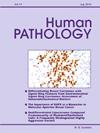BSND: An emerging immunohistochemical marker that reliably distinguishes benign from malignant oncocytic salivary gland tumors
IF 2.6
2区 医学
Q2 PATHOLOGY
引用次数: 0
Abstract
Oncocytic cells appear in various salivary gland lesions (SGLs) like oncocytic hyperplasia, metaplasia and several neoplasms. It is particularly challenging to distinguish oncocytoma and Warthin tumor from oncocytic and Warthin-like mucoepidermoid carcinoma (MEC) in the absence of molecular testing. A spectrum of oncocytic SGLs underwent immunohistochemistry for BSND, a novel marker of striated ducts and oncocytic tumor cells. MAML2 fluorescence in situ hybridization (FISH) was performed in suspected MECs.
BSND immunoexpression was assessed in 138 SGLs, including 132 in-house and 4 consult cases. In-house cases comprised 5 non-neoplastic, 43 benign and 84 malignant SGLs. All nodular oncocytic hyperplasia (100 %) were BSND positive, while intercalated duct hyperplasia was negative. Among benign tumors, oncocytic cystadenomas (3/3), Warthin tumor (15/15), and oncocytoma (1/1) were BSND-positive (100 %). One clear cell oncocytoma reclassified as clear cell MEC on resection was BSND-negative. All remaining benign tumors were negative. Among all malignant tumors, one Warthin-like MEC was reclassified as infarcted metaplastic Warthin tumor on morphology and as it lacked MAML2 rearrangement; it was BSND positive. All remaining 83 malignant neoplasms were BSND-negative (100 %). All consult cases submitted as oncocytoma and oncocytic carcinoma were reclassified on ancillary testing, with BSND reliably distinguishing benign from malignant SGLs. In 21 cases with MAML2 FISH, MAML2 rearrangement was mutually exclusive with BSND immunopositivity.
BSND is thus newly validated as an immunomarker to resolve diagnostic uncertainty in oncocytic SGLs. Use of BSND in routine practice could streamline the diagnostic process and improve patient management by reducing reliance on ambiguous morphological features, particularly in settings lacking molecular testing.

BSND:一种新兴的免疫组织化学标记物,可可靠地区分良性和恶性嗜癌性唾液腺肿瘤
嗜酸细胞出现在各种唾液腺病变(SGLs)中,如嗜酸细胞增生、化生和几种肿瘤。在缺乏分子检测的情况下,将嗜瘤细胞瘤和沃辛瘤与嗜瘤细胞癌和沃辛样黏液表皮样癌(MEC)区分开来尤其具有挑战性。对一组嗜癌性SGLs患者进行了BSND免疫组化检测,BSND是一种新的纹状管和嗜癌性肿瘤细胞标记物。对疑似mec进行MAML2荧光原位杂交(FISH)。对138例SGLs进行BSND免疫表达评估,其中132例为住院病例,4例为会诊病例。内部病例包括非肿瘤性5例,良性43例,恶性84例。所有结节性癌细胞增生(100%)均为BSND阳性,而间插管增生为阴性。良性肿瘤中,嗜瘤性囊腺瘤(3/3)、Warthin瘤(15/15)、嗜瘤性细胞瘤(1/1)呈bsnd阳性(100%)。一个透明细胞癌在切除后被重新分类为透明细胞癌,bsnd阴性。其余良性肿瘤均为阴性。在所有恶性肿瘤中,1例wartin样MEC因形态学和缺乏MAML2重排而被重新分类为梗死性化生Warthin瘤;BSND呈阳性。其余83例恶性肿瘤均为bsnd阴性(100%)。所有以嗜瘤细胞癌和嗜瘤细胞癌提交的会诊病例在辅助检测中被重新分类,BSND可靠地区分了良性和恶性SGLs。在21例MAML2 FISH中,MAML2重排与BSND免疫阳性相互排斥。因此,BSND最近被证实是一种免疫标志物,可用于解决嗜瘤细胞性SGLs的诊断不确定性。在常规实践中使用BSND可以简化诊断过程,并通过减少对模糊形态学特征的依赖来改善患者管理,特别是在缺乏分子检测的情况下。
本文章由计算机程序翻译,如有差异,请以英文原文为准。
求助全文
约1分钟内获得全文
求助全文
来源期刊

Human pathology
医学-病理学
CiteScore
5.30
自引率
6.10%
发文量
206
审稿时长
21 days
期刊介绍:
Human Pathology is designed to bring information of clinicopathologic significance to human disease to the laboratory and clinical physician. It presents information drawn from morphologic and clinical laboratory studies with direct relevance to the understanding of human diseases. Papers published concern morphologic and clinicopathologic observations, reviews of diseases, analyses of problems in pathology, significant collections of case material and advances in concepts or techniques of value in the analysis and diagnosis of disease. Theoretical and experimental pathology and molecular biology pertinent to human disease are included. This critical journal is well illustrated with exceptional reproductions of photomicrographs and microscopic anatomy.
 求助内容:
求助内容: 应助结果提醒方式:
应助结果提醒方式:


